Auditing and Assurance Report: Audit Assertions, Risks and Procedures
VerifiedAdded on 2022/09/17
|15
|3594
|10
Report
AI Summary
This report provides an in-depth analysis of auditing and assurance principles, focusing on two case studies: Computing Solutions Limited and Beautiful Hair. The report begins by identifying key audit assertions at risk, including accuracy and cut-off for inventory in Computing Solutions, and rights & obl...
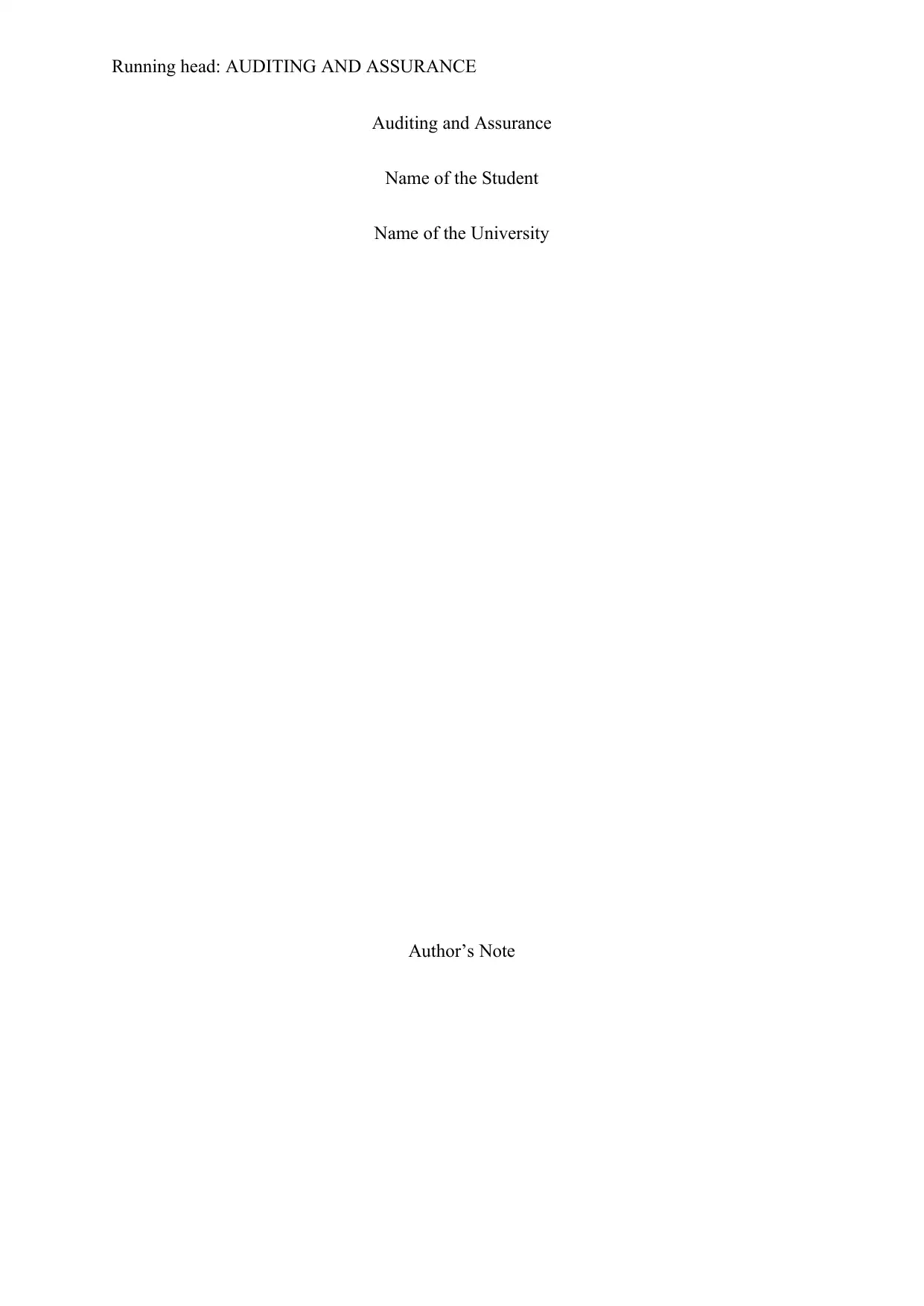
Running head: AUDITING AND ASSURANCE
Auditing and Assurance
Name of the Student
Name of the University
Author’s Note
Auditing and Assurance
Name of the Student
Name of the University
Author’s Note
Paraphrase This Document
Need a fresh take? Get an instant paraphrase of this document with our AI Paraphraser

1AUDITING AND ASSURANCE
Executive Summary
Discussion on the audit assertions and the risks in those audit assertions is the main objective
of this study. After the identification of assertions at risk, this report discusses about the
adoption of appropriate substantive audit procedures for these two cases. Another major part
of this report is to shed light on the necessary requirements of key audit matters in accordance
with the requirements of ASA 701 Communicating Key Audit Matters.
Executive Summary
Discussion on the audit assertions and the risks in those audit assertions is the main objective
of this study. After the identification of assertions at risk, this report discusses about the
adoption of appropriate substantive audit procedures for these two cases. Another major part
of this report is to shed light on the necessary requirements of key audit matters in accordance
with the requirements of ASA 701 Communicating Key Audit Matters.
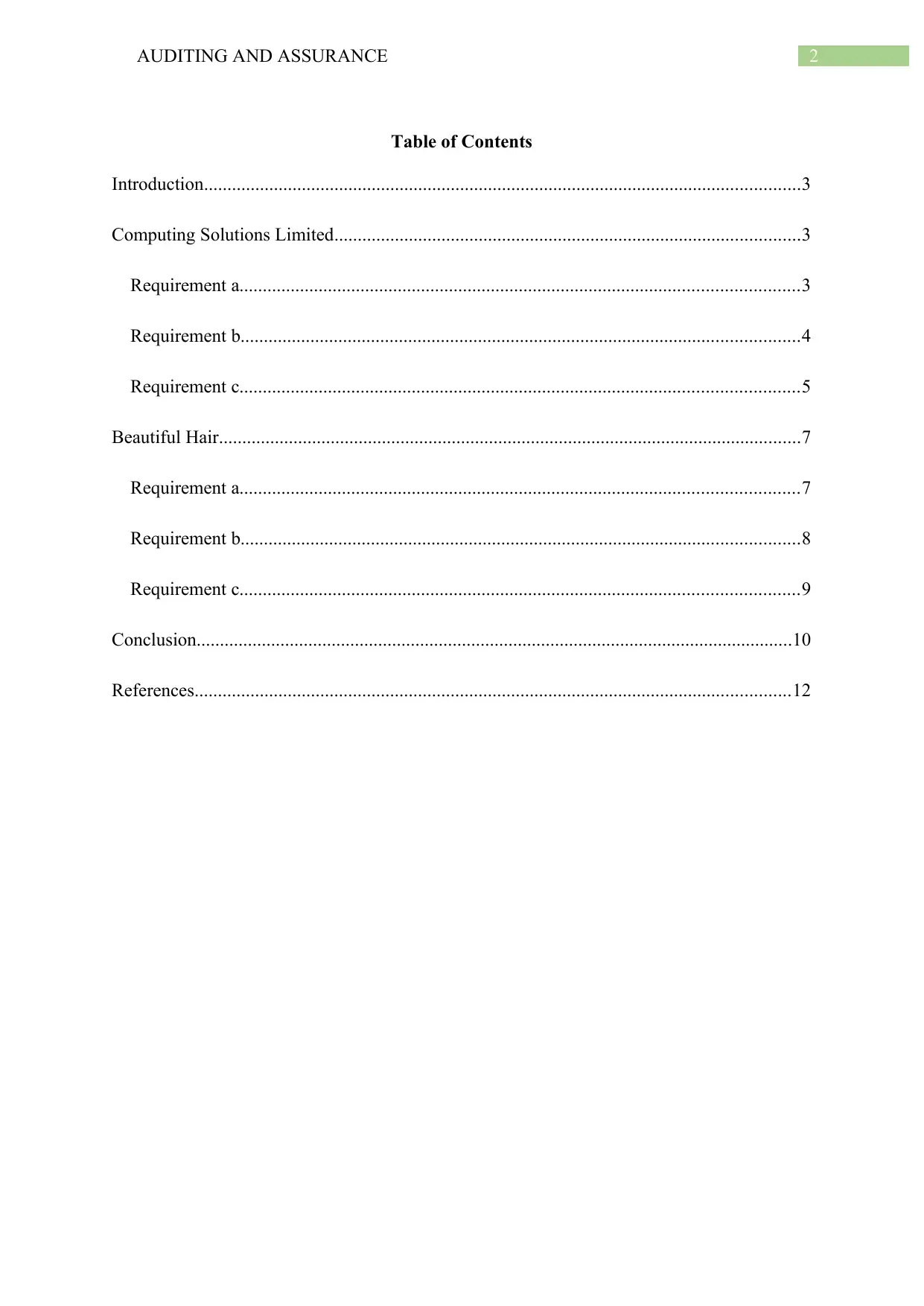
2AUDITING AND ASSURANCE
Table of Contents
Introduction................................................................................................................................3
Computing Solutions Limited....................................................................................................3
Requirement a........................................................................................................................3
Requirement b........................................................................................................................4
Requirement c........................................................................................................................5
Beautiful Hair.............................................................................................................................7
Requirement a........................................................................................................................7
Requirement b........................................................................................................................8
Requirement c........................................................................................................................9
Conclusion................................................................................................................................10
References................................................................................................................................12
Table of Contents
Introduction................................................................................................................................3
Computing Solutions Limited....................................................................................................3
Requirement a........................................................................................................................3
Requirement b........................................................................................................................4
Requirement c........................................................................................................................5
Beautiful Hair.............................................................................................................................7
Requirement a........................................................................................................................7
Requirement b........................................................................................................................8
Requirement c........................................................................................................................9
Conclusion................................................................................................................................10
References................................................................................................................................12
You're viewing a preview
Unlock full access by subscribing today!
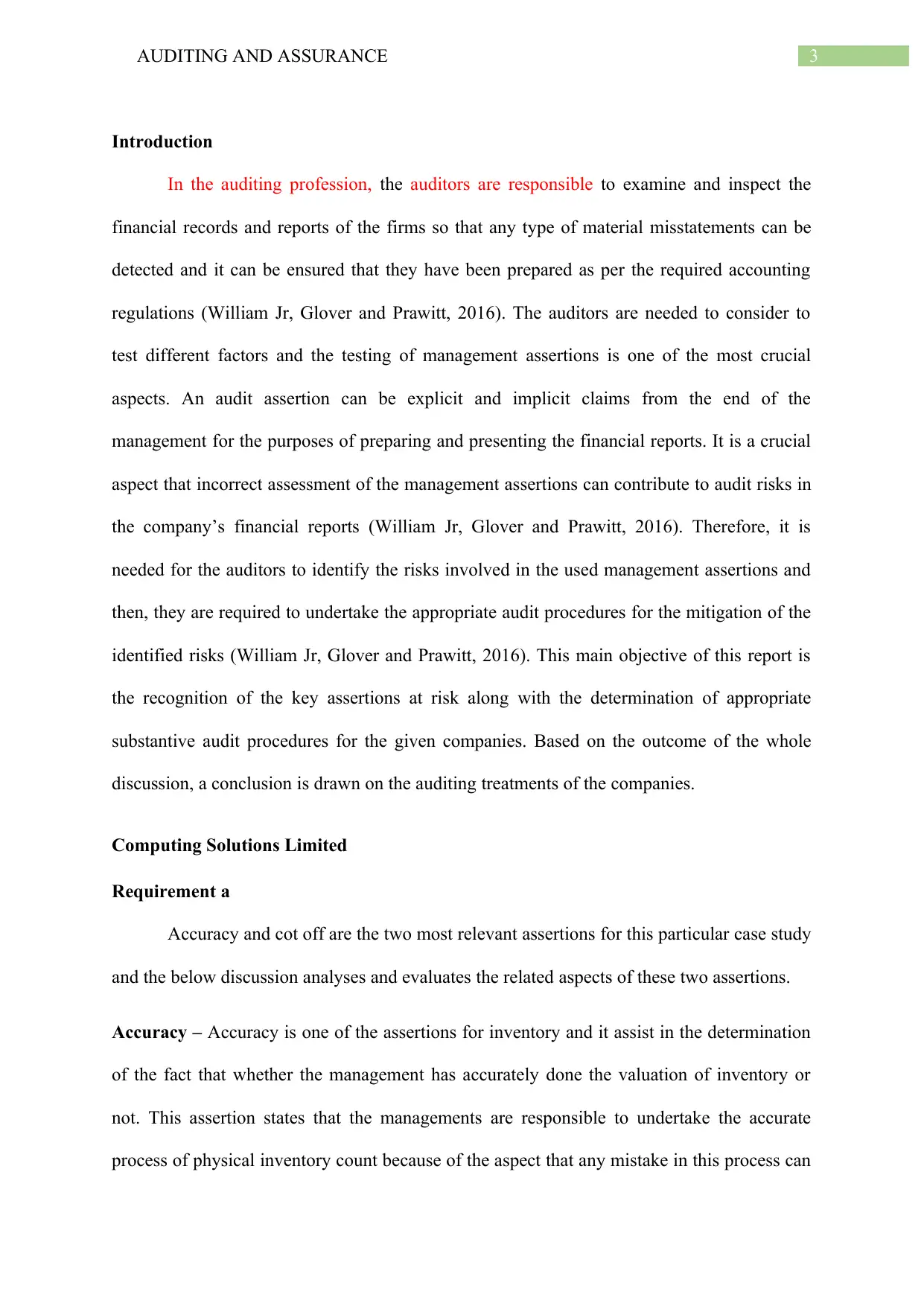
3AUDITING AND ASSURANCE
Introduction
In the auditing profession, the auditors are responsible to examine and inspect the
financial records and reports of the firms so that any type of material misstatements can be
detected and it can be ensured that they have been prepared as per the required accounting
regulations (William Jr, Glover and Prawitt, 2016). The auditors are needed to consider to
test different factors and the testing of management assertions is one of the most crucial
aspects. An audit assertion can be explicit and implicit claims from the end of the
management for the purposes of preparing and presenting the financial reports. It is a crucial
aspect that incorrect assessment of the management assertions can contribute to audit risks in
the company’s financial reports (William Jr, Glover and Prawitt, 2016). Therefore, it is
needed for the auditors to identify the risks involved in the used management assertions and
then, they are required to undertake the appropriate audit procedures for the mitigation of the
identified risks (William Jr, Glover and Prawitt, 2016). This main objective of this report is
the recognition of the key assertions at risk along with the determination of appropriate
substantive audit procedures for the given companies. Based on the outcome of the whole
discussion, a conclusion is drawn on the auditing treatments of the companies.
Computing Solutions Limited
Requirement a
Accuracy and cot off are the two most relevant assertions for this particular case study
and the below discussion analyses and evaluates the related aspects of these two assertions.
Accuracy – Accuracy is one of the assertions for inventory and it assist in the determination
of the fact that whether the management has accurately done the valuation of inventory or
not. This assertion states that the managements are responsible to undertake the accurate
process of physical inventory count because of the aspect that any mistake in this process can
Introduction
In the auditing profession, the auditors are responsible to examine and inspect the
financial records and reports of the firms so that any type of material misstatements can be
detected and it can be ensured that they have been prepared as per the required accounting
regulations (William Jr, Glover and Prawitt, 2016). The auditors are needed to consider to
test different factors and the testing of management assertions is one of the most crucial
aspects. An audit assertion can be explicit and implicit claims from the end of the
management for the purposes of preparing and presenting the financial reports. It is a crucial
aspect that incorrect assessment of the management assertions can contribute to audit risks in
the company’s financial reports (William Jr, Glover and Prawitt, 2016). Therefore, it is
needed for the auditors to identify the risks involved in the used management assertions and
then, they are required to undertake the appropriate audit procedures for the mitigation of the
identified risks (William Jr, Glover and Prawitt, 2016). This main objective of this report is
the recognition of the key assertions at risk along with the determination of appropriate
substantive audit procedures for the given companies. Based on the outcome of the whole
discussion, a conclusion is drawn on the auditing treatments of the companies.
Computing Solutions Limited
Requirement a
Accuracy and cot off are the two most relevant assertions for this particular case study
and the below discussion analyses and evaluates the related aspects of these two assertions.
Accuracy – Accuracy is one of the assertions for inventory and it assist in the determination
of the fact that whether the management has accurately done the valuation of inventory or
not. This assertion states that the managements are responsible to undertake the accurate
process of physical inventory count because of the aspect that any mistake in this process can
Paraphrase This Document
Need a fresh take? Get an instant paraphrase of this document with our AI Paraphraser
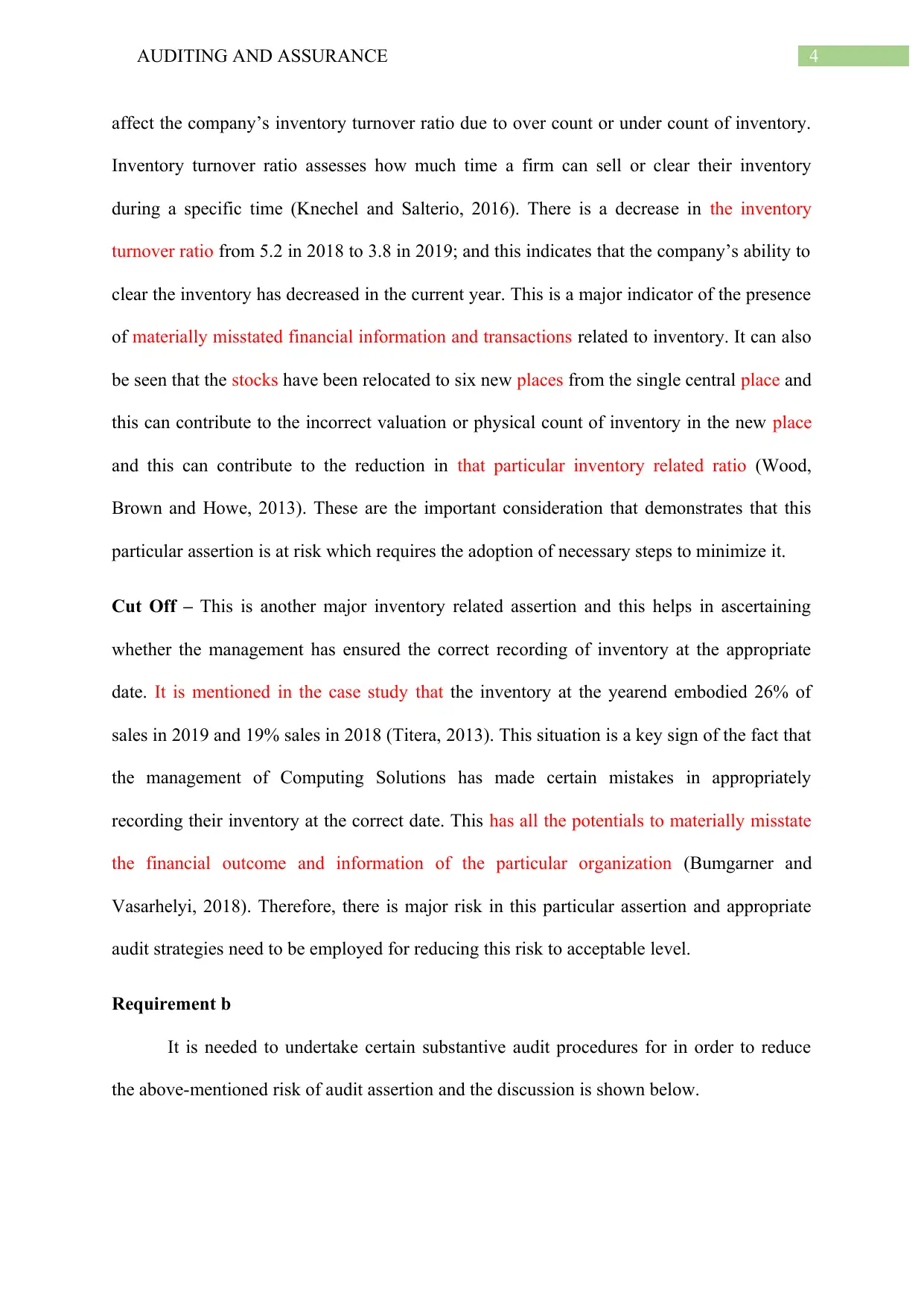
4AUDITING AND ASSURANCE
affect the company’s inventory turnover ratio due to over count or under count of inventory.
Inventory turnover ratio assesses how much time a firm can sell or clear their inventory
during a specific time (Knechel and Salterio, 2016). There is a decrease in the inventory
turnover ratio from 5.2 in 2018 to 3.8 in 2019; and this indicates that the company’s ability to
clear the inventory has decreased in the current year. This is a major indicator of the presence
of materially misstated financial information and transactions related to inventory. It can also
be seen that the stocks have been relocated to six new places from the single central place and
this can contribute to the incorrect valuation or physical count of inventory in the new place
and this can contribute to the reduction in that particular inventory related ratio (Wood,
Brown and Howe, 2013). These are the important consideration that demonstrates that this
particular assertion is at risk which requires the adoption of necessary steps to minimize it.
Cut Off – This is another major inventory related assertion and this helps in ascertaining
whether the management has ensured the correct recording of inventory at the appropriate
date. It is mentioned in the case study that the inventory at the yearend embodied 26% of
sales in 2019 and 19% sales in 2018 (Titera, 2013). This situation is a key sign of the fact that
the management of Computing Solutions has made certain mistakes in appropriately
recording their inventory at the correct date. This has all the potentials to materially misstate
the financial outcome and information of the particular organization (Bumgarner and
Vasarhelyi, 2018). Therefore, there is major risk in this particular assertion and appropriate
audit strategies need to be employed for reducing this risk to acceptable level.
Requirement b
It is needed to undertake certain substantive audit procedures for in order to reduce
the above-mentioned risk of audit assertion and the discussion is shown below.
affect the company’s inventory turnover ratio due to over count or under count of inventory.
Inventory turnover ratio assesses how much time a firm can sell or clear their inventory
during a specific time (Knechel and Salterio, 2016). There is a decrease in the inventory
turnover ratio from 5.2 in 2018 to 3.8 in 2019; and this indicates that the company’s ability to
clear the inventory has decreased in the current year. This is a major indicator of the presence
of materially misstated financial information and transactions related to inventory. It can also
be seen that the stocks have been relocated to six new places from the single central place and
this can contribute to the incorrect valuation or physical count of inventory in the new place
and this can contribute to the reduction in that particular inventory related ratio (Wood,
Brown and Howe, 2013). These are the important consideration that demonstrates that this
particular assertion is at risk which requires the adoption of necessary steps to minimize it.
Cut Off – This is another major inventory related assertion and this helps in ascertaining
whether the management has ensured the correct recording of inventory at the appropriate
date. It is mentioned in the case study that the inventory at the yearend embodied 26% of
sales in 2019 and 19% sales in 2018 (Titera, 2013). This situation is a key sign of the fact that
the management of Computing Solutions has made certain mistakes in appropriately
recording their inventory at the correct date. This has all the potentials to materially misstate
the financial outcome and information of the particular organization (Bumgarner and
Vasarhelyi, 2018). Therefore, there is major risk in this particular assertion and appropriate
audit strategies need to be employed for reducing this risk to acceptable level.
Requirement b
It is needed to undertake certain substantive audit procedures for in order to reduce
the above-mentioned risk of audit assertion and the discussion is shown below.
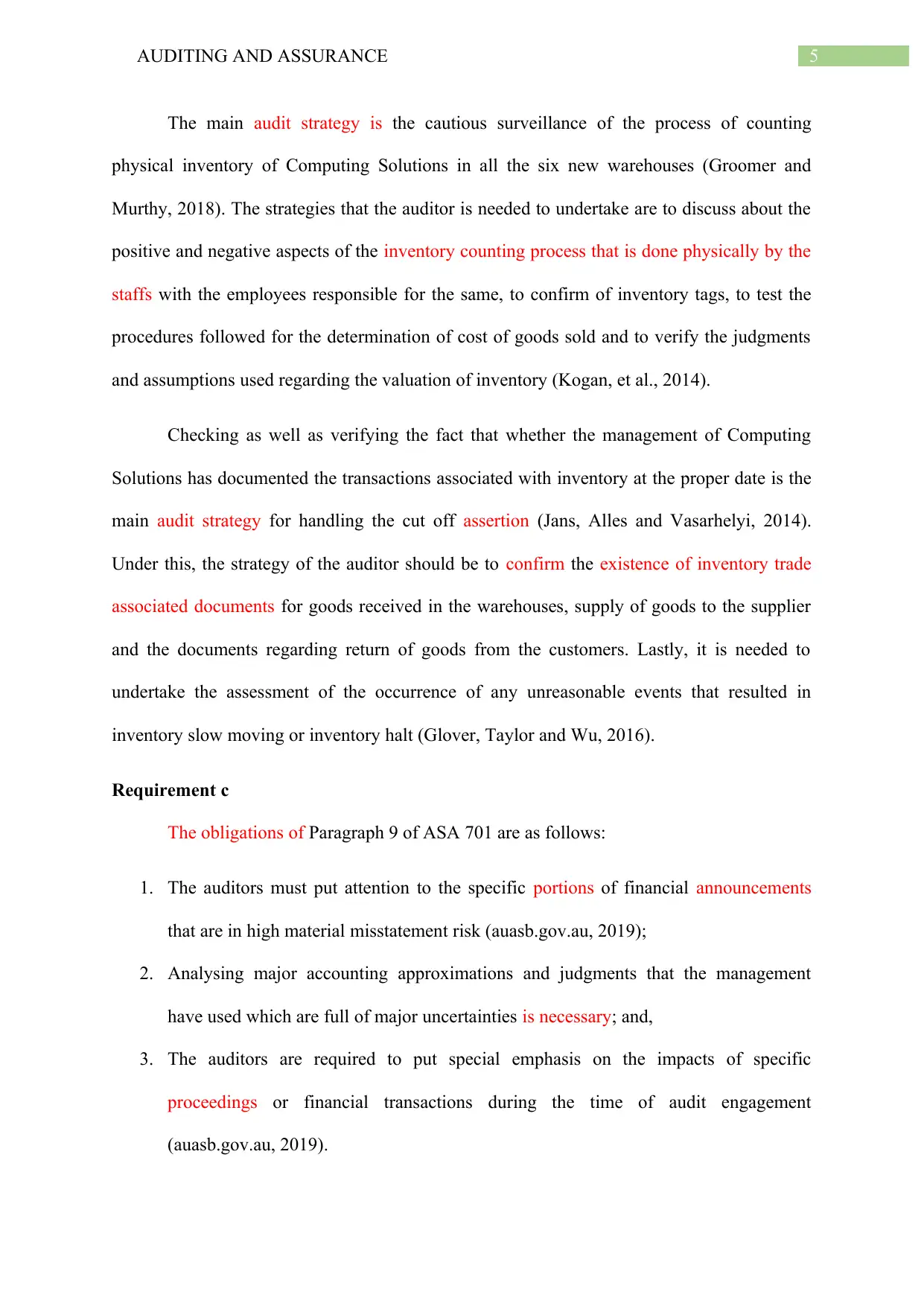
5AUDITING AND ASSURANCE
The main audit strategy is the cautious surveillance of the process of counting
physical inventory of Computing Solutions in all the six new warehouses (Groomer and
Murthy, 2018). The strategies that the auditor is needed to undertake are to discuss about the
positive and negative aspects of the inventory counting process that is done physically by the
staffs with the employees responsible for the same, to confirm of inventory tags, to test the
procedures followed for the determination of cost of goods sold and to verify the judgments
and assumptions used regarding the valuation of inventory (Kogan, et al., 2014).
Checking as well as verifying the fact that whether the management of Computing
Solutions has documented the transactions associated with inventory at the proper date is the
main audit strategy for handling the cut off assertion (Jans, Alles and Vasarhelyi, 2014).
Under this, the strategy of the auditor should be to confirm the existence of inventory trade
associated documents for goods received in the warehouses, supply of goods to the supplier
and the documents regarding return of goods from the customers. Lastly, it is needed to
undertake the assessment of the occurrence of any unreasonable events that resulted in
inventory slow moving or inventory halt (Glover, Taylor and Wu, 2016).
Requirement c
The obligations of Paragraph 9 of ASA 701 are as follows:
1. The auditors must put attention to the specific portions of financial announcements
that are in high material misstatement risk (auasb.gov.au, 2019);
2. Analysing major accounting approximations and judgments that the management
have used which are full of major uncertainties is necessary; and,
3. The auditors are required to put special emphasis on the impacts of specific
proceedings or financial transactions during the time of audit engagement
(auasb.gov.au, 2019).
The main audit strategy is the cautious surveillance of the process of counting
physical inventory of Computing Solutions in all the six new warehouses (Groomer and
Murthy, 2018). The strategies that the auditor is needed to undertake are to discuss about the
positive and negative aspects of the inventory counting process that is done physically by the
staffs with the employees responsible for the same, to confirm of inventory tags, to test the
procedures followed for the determination of cost of goods sold and to verify the judgments
and assumptions used regarding the valuation of inventory (Kogan, et al., 2014).
Checking as well as verifying the fact that whether the management of Computing
Solutions has documented the transactions associated with inventory at the proper date is the
main audit strategy for handling the cut off assertion (Jans, Alles and Vasarhelyi, 2014).
Under this, the strategy of the auditor should be to confirm the existence of inventory trade
associated documents for goods received in the warehouses, supply of goods to the supplier
and the documents regarding return of goods from the customers. Lastly, it is needed to
undertake the assessment of the occurrence of any unreasonable events that resulted in
inventory slow moving or inventory halt (Glover, Taylor and Wu, 2016).
Requirement c
The obligations of Paragraph 9 of ASA 701 are as follows:
1. The auditors must put attention to the specific portions of financial announcements
that are in high material misstatement risk (auasb.gov.au, 2019);
2. Analysing major accounting approximations and judgments that the management
have used which are full of major uncertainties is necessary; and,
3. The auditors are required to put special emphasis on the impacts of specific
proceedings or financial transactions during the time of audit engagement
(auasb.gov.au, 2019).
You're viewing a preview
Unlock full access by subscribing today!
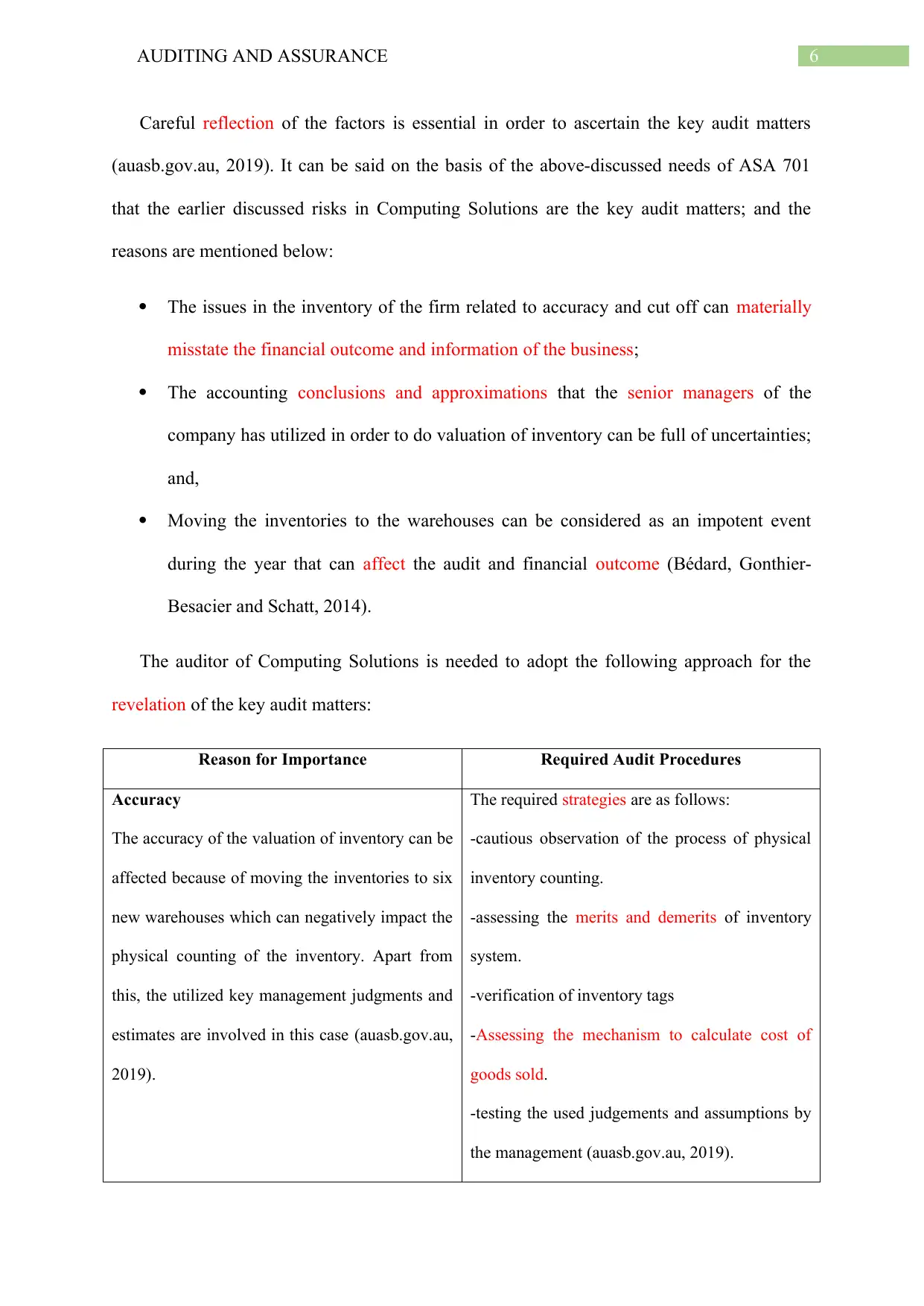
6AUDITING AND ASSURANCE
Careful reflection of the factors is essential in order to ascertain the key audit matters
(auasb.gov.au, 2019). It can be said on the basis of the above-discussed needs of ASA 701
that the earlier discussed risks in Computing Solutions are the key audit matters; and the
reasons are mentioned below:
The issues in the inventory of the firm related to accuracy and cut off can materially
misstate the financial outcome and information of the business;
The accounting conclusions and approximations that the senior managers of the
company has utilized in order to do valuation of inventory can be full of uncertainties;
and,
Moving the inventories to the warehouses can be considered as an impotent event
during the year that can affect the audit and financial outcome (Bédard, Gonthier-
Besacier and Schatt, 2014).
The auditor of Computing Solutions is needed to adopt the following approach for the
revelation of the key audit matters:
Reason for Importance Required Audit Procedures
Accuracy
The accuracy of the valuation of inventory can be
affected because of moving the inventories to six
new warehouses which can negatively impact the
physical counting of the inventory. Apart from
this, the utilized key management judgments and
estimates are involved in this case (auasb.gov.au,
2019).
The required strategies are as follows:
-cautious observation of the process of physical
inventory counting.
-assessing the merits and demerits of inventory
system.
-verification of inventory tags
-Assessing the mechanism to calculate cost of
goods sold.
-testing the used judgements and assumptions by
the management (auasb.gov.au, 2019).
Careful reflection of the factors is essential in order to ascertain the key audit matters
(auasb.gov.au, 2019). It can be said on the basis of the above-discussed needs of ASA 701
that the earlier discussed risks in Computing Solutions are the key audit matters; and the
reasons are mentioned below:
The issues in the inventory of the firm related to accuracy and cut off can materially
misstate the financial outcome and information of the business;
The accounting conclusions and approximations that the senior managers of the
company has utilized in order to do valuation of inventory can be full of uncertainties;
and,
Moving the inventories to the warehouses can be considered as an impotent event
during the year that can affect the audit and financial outcome (Bédard, Gonthier-
Besacier and Schatt, 2014).
The auditor of Computing Solutions is needed to adopt the following approach for the
revelation of the key audit matters:
Reason for Importance Required Audit Procedures
Accuracy
The accuracy of the valuation of inventory can be
affected because of moving the inventories to six
new warehouses which can negatively impact the
physical counting of the inventory. Apart from
this, the utilized key management judgments and
estimates are involved in this case (auasb.gov.au,
2019).
The required strategies are as follows:
-cautious observation of the process of physical
inventory counting.
-assessing the merits and demerits of inventory
system.
-verification of inventory tags
-Assessing the mechanism to calculate cost of
goods sold.
-testing the used judgements and assumptions by
the management (auasb.gov.au, 2019).
Paraphrase This Document
Need a fresh take? Get an instant paraphrase of this document with our AI Paraphraser
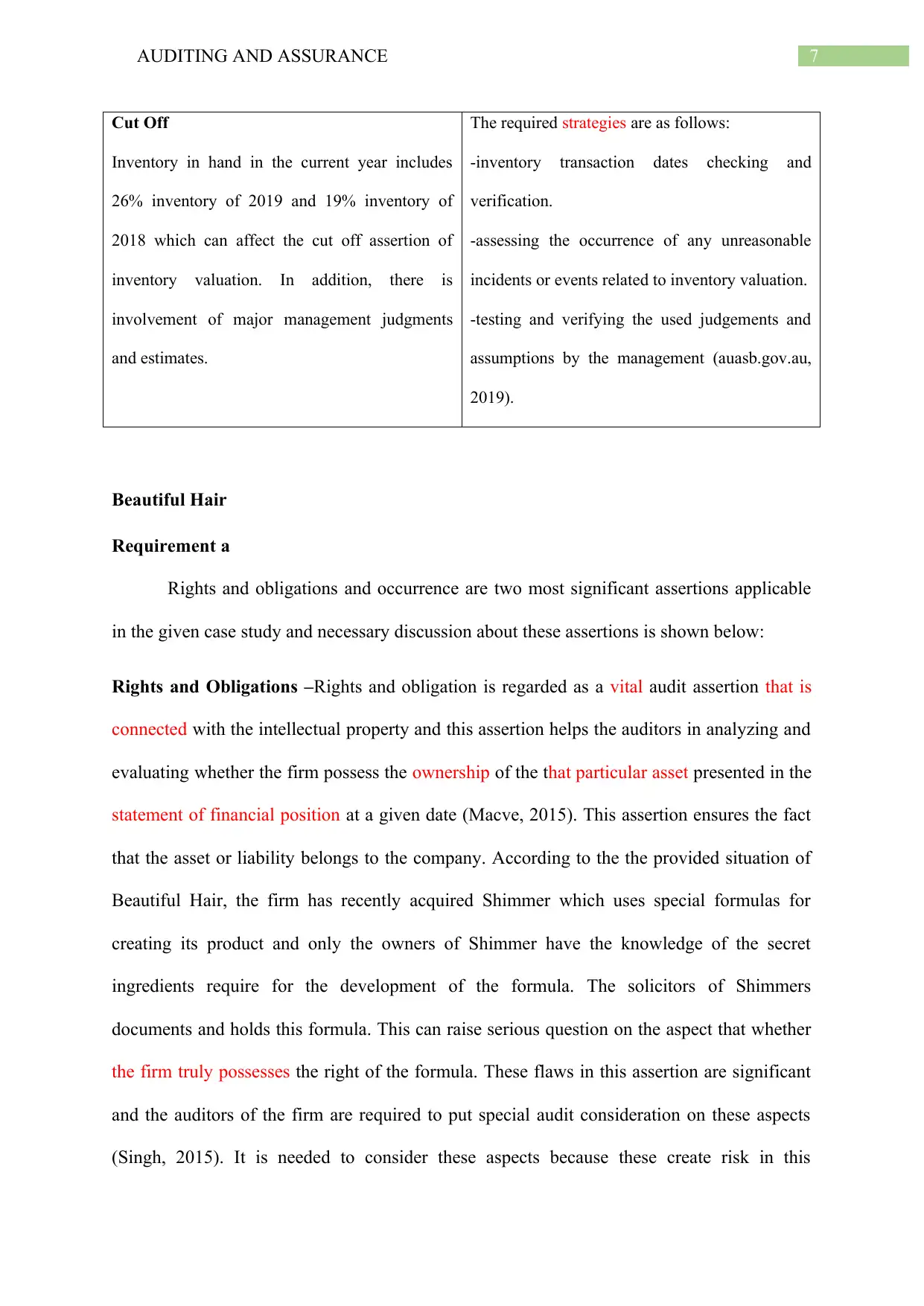
7AUDITING AND ASSURANCE
Cut Off
Inventory in hand in the current year includes
26% inventory of 2019 and 19% inventory of
2018 which can affect the cut off assertion of
inventory valuation. In addition, there is
involvement of major management judgments
and estimates.
The required strategies are as follows:
-inventory transaction dates checking and
verification.
-assessing the occurrence of any unreasonable
incidents or events related to inventory valuation.
-testing and verifying the used judgements and
assumptions by the management (auasb.gov.au,
2019).
Beautiful Hair
Requirement a
Rights and obligations and occurrence are two most significant assertions applicable
in the given case study and necessary discussion about these assertions is shown below:
Rights and Obligations –Rights and obligation is regarded as a vital audit assertion that is
connected with the intellectual property and this assertion helps the auditors in analyzing and
evaluating whether the firm possess the ownership of the that particular asset presented in the
statement of financial position at a given date (Macve, 2015). This assertion ensures the fact
that the asset or liability belongs to the company. According to the the provided situation of
Beautiful Hair, the firm has recently acquired Shimmer which uses special formulas for
creating its product and only the owners of Shimmer have the knowledge of the secret
ingredients require for the development of the formula. The solicitors of Shimmers
documents and holds this formula. This can raise serious question on the aspect that whether
the firm truly possesses the right of the formula. These flaws in this assertion are significant
and the auditors of the firm are required to put special audit consideration on these aspects
(Singh, 2015). It is needed to consider these aspects because these create risk in this
Cut Off
Inventory in hand in the current year includes
26% inventory of 2019 and 19% inventory of
2018 which can affect the cut off assertion of
inventory valuation. In addition, there is
involvement of major management judgments
and estimates.
The required strategies are as follows:
-inventory transaction dates checking and
verification.
-assessing the occurrence of any unreasonable
incidents or events related to inventory valuation.
-testing and verifying the used judgements and
assumptions by the management (auasb.gov.au,
2019).
Beautiful Hair
Requirement a
Rights and obligations and occurrence are two most significant assertions applicable
in the given case study and necessary discussion about these assertions is shown below:
Rights and Obligations –Rights and obligation is regarded as a vital audit assertion that is
connected with the intellectual property and this assertion helps the auditors in analyzing and
evaluating whether the firm possess the ownership of the that particular asset presented in the
statement of financial position at a given date (Macve, 2015). This assertion ensures the fact
that the asset or liability belongs to the company. According to the the provided situation of
Beautiful Hair, the firm has recently acquired Shimmer which uses special formulas for
creating its product and only the owners of Shimmer have the knowledge of the secret
ingredients require for the development of the formula. The solicitors of Shimmers
documents and holds this formula. This can raise serious question on the aspect that whether
the firm truly possesses the right of the formula. These flaws in this assertion are significant
and the auditors of the firm are required to put special audit consideration on these aspects
(Singh, 2015). It is needed to consider these aspects because these create risk in this
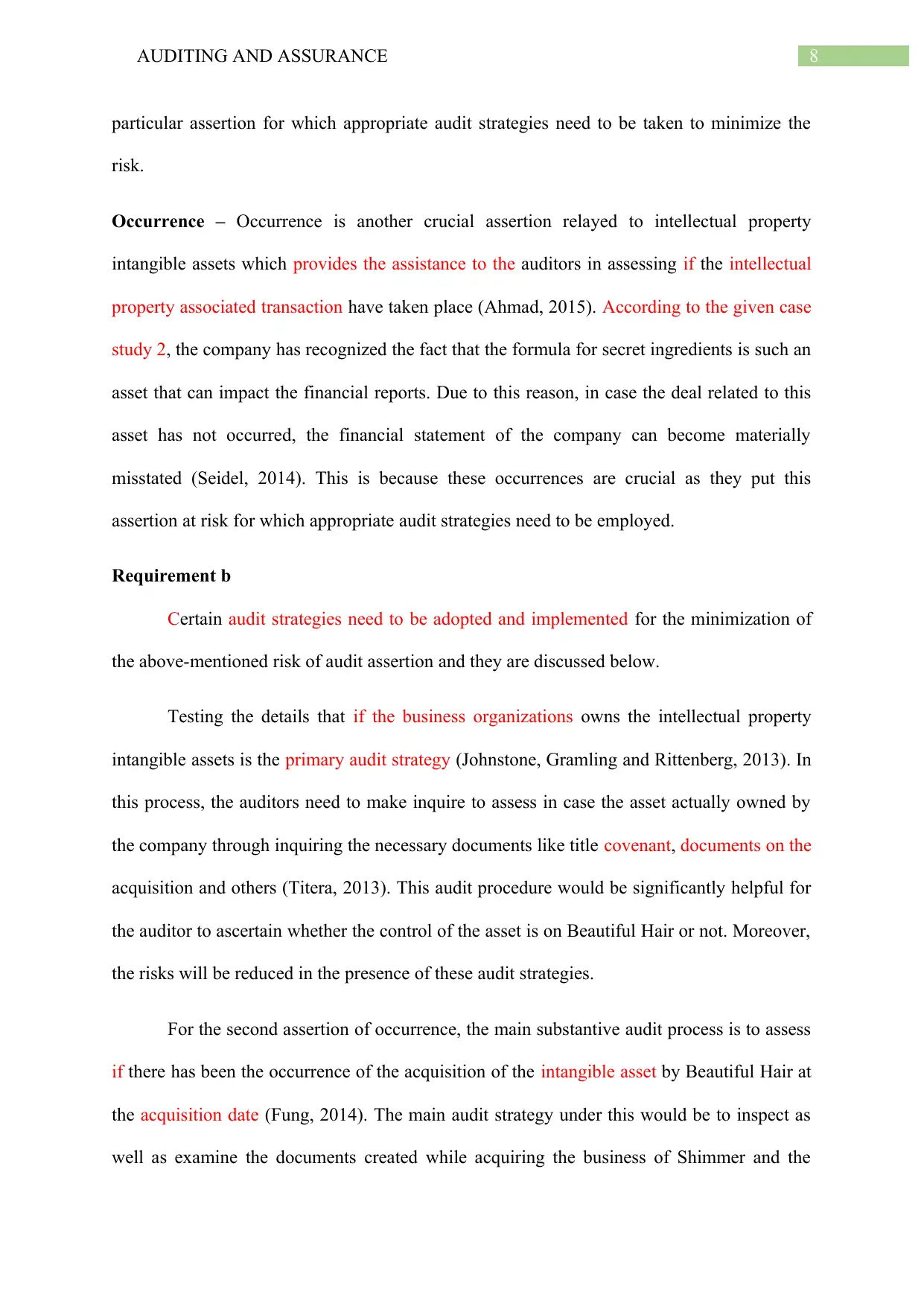
8AUDITING AND ASSURANCE
particular assertion for which appropriate audit strategies need to be taken to minimize the
risk.
Occurrence – Occurrence is another crucial assertion relayed to intellectual property
intangible assets which provides the assistance to the auditors in assessing if the intellectual
property associated transaction have taken place (Ahmad, 2015). According to the given case
study 2, the company has recognized the fact that the formula for secret ingredients is such an
asset that can impact the financial reports. Due to this reason, in case the deal related to this
asset has not occurred, the financial statement of the company can become materially
misstated (Seidel, 2014). This is because these occurrences are crucial as they put this
assertion at risk for which appropriate audit strategies need to be employed.
Requirement b
Certain audit strategies need to be adopted and implemented for the minimization of
the above-mentioned risk of audit assertion and they are discussed below.
Testing the details that if the business organizations owns the intellectual property
intangible assets is the primary audit strategy (Johnstone, Gramling and Rittenberg, 2013). In
this process, the auditors need to make inquire to assess in case the asset actually owned by
the company through inquiring the necessary documents like title covenant, documents on the
acquisition and others (Titera, 2013). This audit procedure would be significantly helpful for
the auditor to ascertain whether the control of the asset is on Beautiful Hair or not. Moreover,
the risks will be reduced in the presence of these audit strategies.
For the second assertion of occurrence, the main substantive audit process is to assess
if there has been the occurrence of the acquisition of the intangible asset by Beautiful Hair at
the acquisition date (Fung, 2014). The main audit strategy under this would be to inspect as
well as examine the documents created while acquiring the business of Shimmer and the
particular assertion for which appropriate audit strategies need to be taken to minimize the
risk.
Occurrence – Occurrence is another crucial assertion relayed to intellectual property
intangible assets which provides the assistance to the auditors in assessing if the intellectual
property associated transaction have taken place (Ahmad, 2015). According to the given case
study 2, the company has recognized the fact that the formula for secret ingredients is such an
asset that can impact the financial reports. Due to this reason, in case the deal related to this
asset has not occurred, the financial statement of the company can become materially
misstated (Seidel, 2014). This is because these occurrences are crucial as they put this
assertion at risk for which appropriate audit strategies need to be employed.
Requirement b
Certain audit strategies need to be adopted and implemented for the minimization of
the above-mentioned risk of audit assertion and they are discussed below.
Testing the details that if the business organizations owns the intellectual property
intangible assets is the primary audit strategy (Johnstone, Gramling and Rittenberg, 2013). In
this process, the auditors need to make inquire to assess in case the asset actually owned by
the company through inquiring the necessary documents like title covenant, documents on the
acquisition and others (Titera, 2013). This audit procedure would be significantly helpful for
the auditor to ascertain whether the control of the asset is on Beautiful Hair or not. Moreover,
the risks will be reduced in the presence of these audit strategies.
For the second assertion of occurrence, the main substantive audit process is to assess
if there has been the occurrence of the acquisition of the intangible asset by Beautiful Hair at
the acquisition date (Fung, 2014). The main audit strategy under this would be to inspect as
well as examine the documents created while acquiring the business of Shimmer and the
You're viewing a preview
Unlock full access by subscribing today!
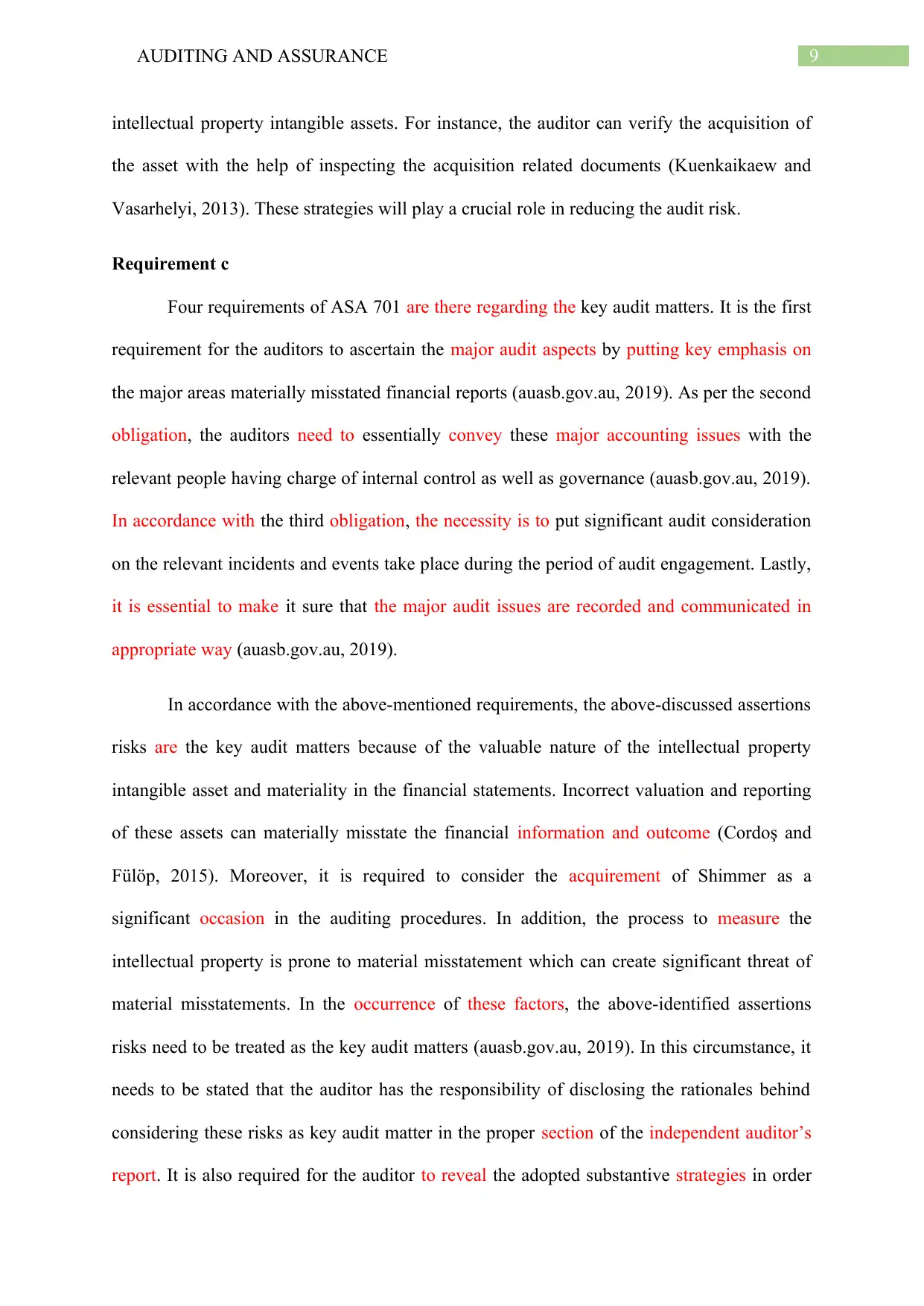
9AUDITING AND ASSURANCE
intellectual property intangible assets. For instance, the auditor can verify the acquisition of
the asset with the help of inspecting the acquisition related documents (Kuenkaikaew and
Vasarhelyi, 2013). These strategies will play a crucial role in reducing the audit risk.
Requirement c
Four requirements of ASA 701 are there regarding the key audit matters. It is the first
requirement for the auditors to ascertain the major audit aspects by putting key emphasis on
the major areas materially misstated financial reports (auasb.gov.au, 2019). As per the second
obligation, the auditors need to essentially convey these major accounting issues with the
relevant people having charge of internal control as well as governance (auasb.gov.au, 2019).
In accordance with the third obligation, the necessity is to put significant audit consideration
on the relevant incidents and events take place during the period of audit engagement. Lastly,
it is essential to make it sure that the major audit issues are recorded and communicated in
appropriate way (auasb.gov.au, 2019).
In accordance with the above-mentioned requirements, the above-discussed assertions
risks are the key audit matters because of the valuable nature of the intellectual property
intangible asset and materiality in the financial statements. Incorrect valuation and reporting
of these assets can materially misstate the financial information and outcome (Cordoş and
Fülöp, 2015). Moreover, it is required to consider the acquirement of Shimmer as a
significant occasion in the auditing procedures. In addition, the process to measure the
intellectual property is prone to material misstatement which can create significant threat of
material misstatements. In the occurrence of these factors, the above-identified assertions
risks need to be treated as the key audit matters (auasb.gov.au, 2019). In this circumstance, it
needs to be stated that the auditor has the responsibility of disclosing the rationales behind
considering these risks as key audit matter in the proper section of the independent auditor’s
report. It is also required for the auditor to reveal the adopted substantive strategies in order
intellectual property intangible assets. For instance, the auditor can verify the acquisition of
the asset with the help of inspecting the acquisition related documents (Kuenkaikaew and
Vasarhelyi, 2013). These strategies will play a crucial role in reducing the audit risk.
Requirement c
Four requirements of ASA 701 are there regarding the key audit matters. It is the first
requirement for the auditors to ascertain the major audit aspects by putting key emphasis on
the major areas materially misstated financial reports (auasb.gov.au, 2019). As per the second
obligation, the auditors need to essentially convey these major accounting issues with the
relevant people having charge of internal control as well as governance (auasb.gov.au, 2019).
In accordance with the third obligation, the necessity is to put significant audit consideration
on the relevant incidents and events take place during the period of audit engagement. Lastly,
it is essential to make it sure that the major audit issues are recorded and communicated in
appropriate way (auasb.gov.au, 2019).
In accordance with the above-mentioned requirements, the above-discussed assertions
risks are the key audit matters because of the valuable nature of the intellectual property
intangible asset and materiality in the financial statements. Incorrect valuation and reporting
of these assets can materially misstate the financial information and outcome (Cordoş and
Fülöp, 2015). Moreover, it is required to consider the acquirement of Shimmer as a
significant occasion in the auditing procedures. In addition, the process to measure the
intellectual property is prone to material misstatement which can create significant threat of
material misstatements. In the occurrence of these factors, the above-identified assertions
risks need to be treated as the key audit matters (auasb.gov.au, 2019). In this circumstance, it
needs to be stated that the auditor has the responsibility of disclosing the rationales behind
considering these risks as key audit matter in the proper section of the independent auditor’s
report. It is also required for the auditor to reveal the adopted substantive strategies in order
Paraphrase This Document
Need a fresh take? Get an instant paraphrase of this document with our AI Paraphraser
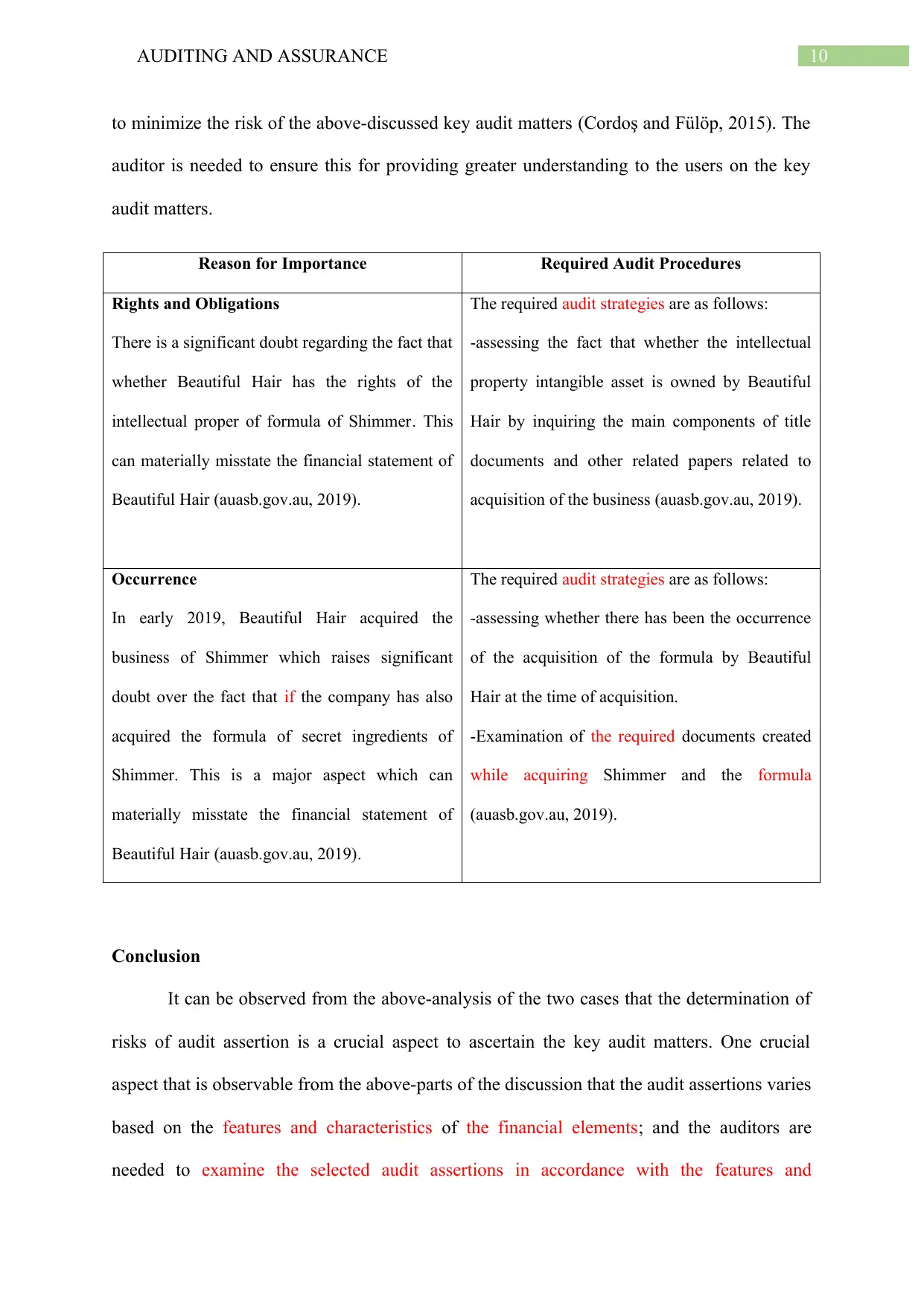
10AUDITING AND ASSURANCE
to minimize the risk of the above-discussed key audit matters (Cordoş and Fülöp, 2015). The
auditor is needed to ensure this for providing greater understanding to the users on the key
audit matters.
Reason for Importance Required Audit Procedures
Rights and Obligations
There is a significant doubt regarding the fact that
whether Beautiful Hair has the rights of the
intellectual proper of formula of Shimmer. This
can materially misstate the financial statement of
Beautiful Hair (auasb.gov.au, 2019).
The required audit strategies are as follows:
-assessing the fact that whether the intellectual
property intangible asset is owned by Beautiful
Hair by inquiring the main components of title
documents and other related papers related to
acquisition of the business (auasb.gov.au, 2019).
Occurrence
In early 2019, Beautiful Hair acquired the
business of Shimmer which raises significant
doubt over the fact that if the company has also
acquired the formula of secret ingredients of
Shimmer. This is a major aspect which can
materially misstate the financial statement of
Beautiful Hair (auasb.gov.au, 2019).
The required audit strategies are as follows:
-assessing whether there has been the occurrence
of the acquisition of the formula by Beautiful
Hair at the time of acquisition.
-Examination of the required documents created
while acquiring Shimmer and the formula
(auasb.gov.au, 2019).
Conclusion
It can be observed from the above-analysis of the two cases that the determination of
risks of audit assertion is a crucial aspect to ascertain the key audit matters. One crucial
aspect that is observable from the above-parts of the discussion that the audit assertions varies
based on the features and characteristics of the financial elements; and the auditors are
needed to examine the selected audit assertions in accordance with the features and
to minimize the risk of the above-discussed key audit matters (Cordoş and Fülöp, 2015). The
auditor is needed to ensure this for providing greater understanding to the users on the key
audit matters.
Reason for Importance Required Audit Procedures
Rights and Obligations
There is a significant doubt regarding the fact that
whether Beautiful Hair has the rights of the
intellectual proper of formula of Shimmer. This
can materially misstate the financial statement of
Beautiful Hair (auasb.gov.au, 2019).
The required audit strategies are as follows:
-assessing the fact that whether the intellectual
property intangible asset is owned by Beautiful
Hair by inquiring the main components of title
documents and other related papers related to
acquisition of the business (auasb.gov.au, 2019).
Occurrence
In early 2019, Beautiful Hair acquired the
business of Shimmer which raises significant
doubt over the fact that if the company has also
acquired the formula of secret ingredients of
Shimmer. This is a major aspect which can
materially misstate the financial statement of
Beautiful Hair (auasb.gov.au, 2019).
The required audit strategies are as follows:
-assessing whether there has been the occurrence
of the acquisition of the formula by Beautiful
Hair at the time of acquisition.
-Examination of the required documents created
while acquiring Shimmer and the formula
(auasb.gov.au, 2019).
Conclusion
It can be observed from the above-analysis of the two cases that the determination of
risks of audit assertion is a crucial aspect to ascertain the key audit matters. One crucial
aspect that is observable from the above-parts of the discussion that the audit assertions varies
based on the features and characteristics of the financial elements; and the auditors are
needed to examine the selected audit assertions in accordance with the features and
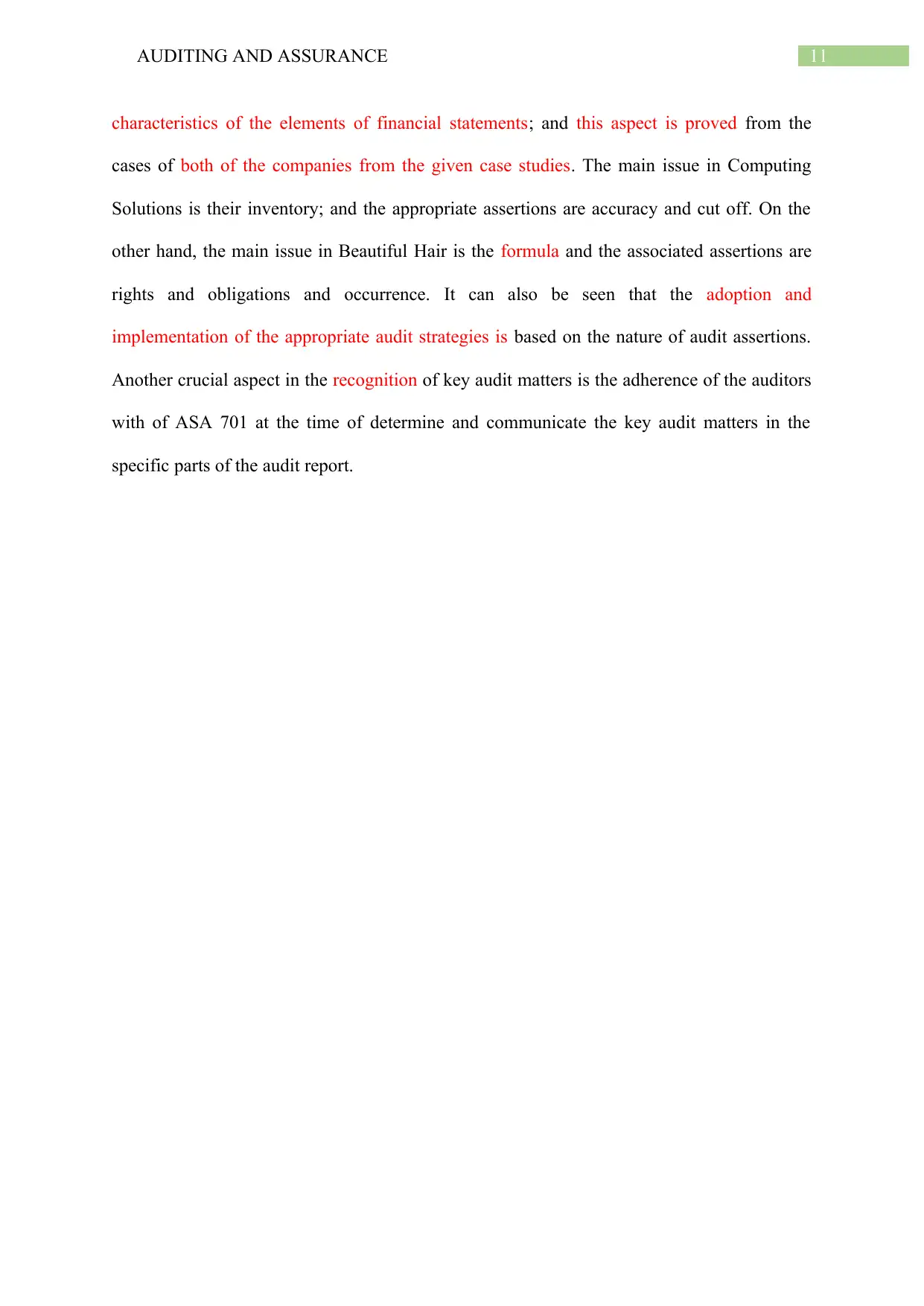
11AUDITING AND ASSURANCE
characteristics of the elements of financial statements; and this aspect is proved from the
cases of both of the companies from the given case studies. The main issue in Computing
Solutions is their inventory; and the appropriate assertions are accuracy and cut off. On the
other hand, the main issue in Beautiful Hair is the formula and the associated assertions are
rights and obligations and occurrence. It can also be seen that the adoption and
implementation of the appropriate audit strategies is based on the nature of audit assertions.
Another crucial aspect in the recognition of key audit matters is the adherence of the auditors
with of ASA 701 at the time of determine and communicate the key audit matters in the
specific parts of the audit report.
characteristics of the elements of financial statements; and this aspect is proved from the
cases of both of the companies from the given case studies. The main issue in Computing
Solutions is their inventory; and the appropriate assertions are accuracy and cut off. On the
other hand, the main issue in Beautiful Hair is the formula and the associated assertions are
rights and obligations and occurrence. It can also be seen that the adoption and
implementation of the appropriate audit strategies is based on the nature of audit assertions.
Another crucial aspect in the recognition of key audit matters is the adherence of the auditors
with of ASA 701 at the time of determine and communicate the key audit matters in the
specific parts of the audit report.
You're viewing a preview
Unlock full access by subscribing today!
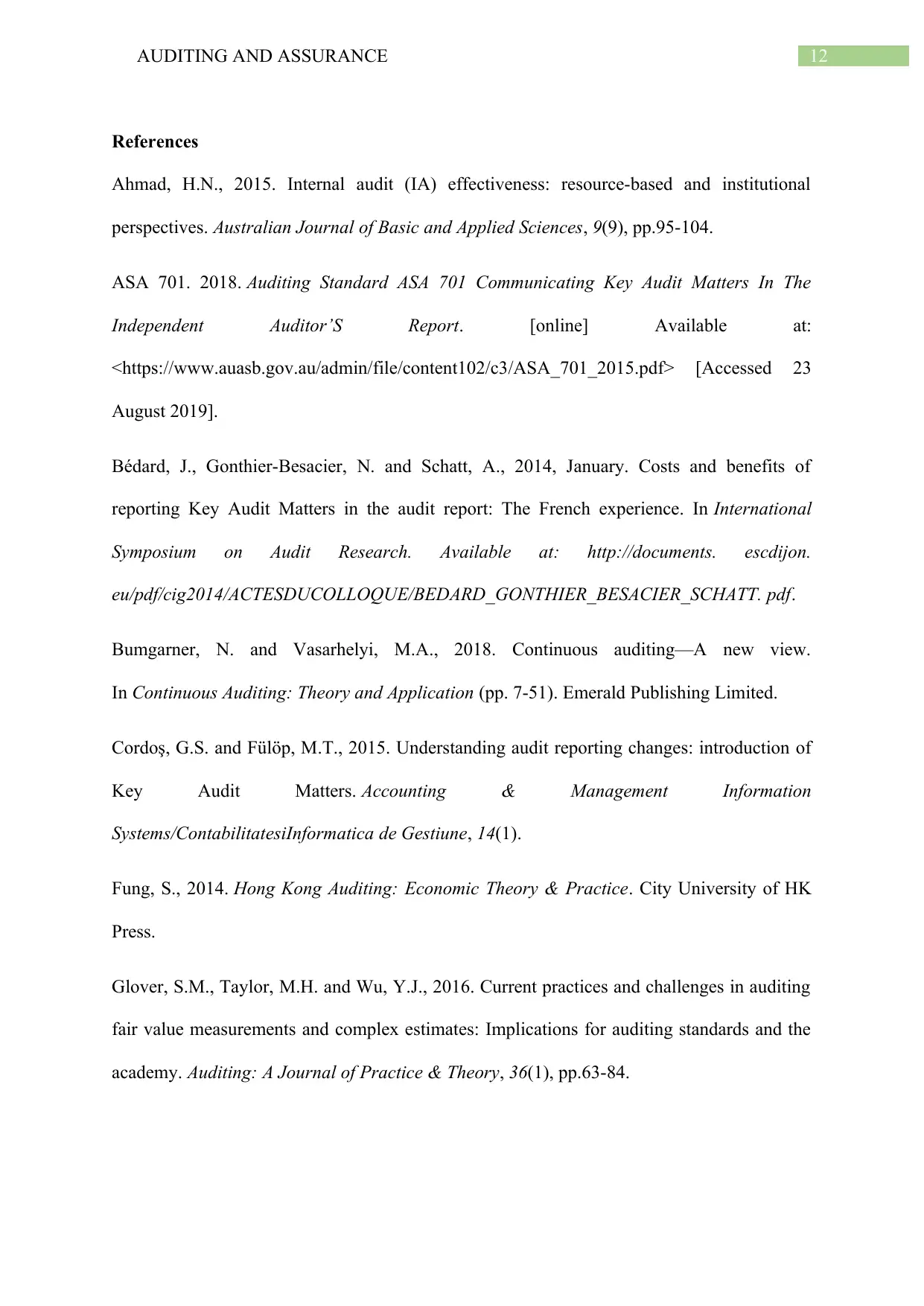
12AUDITING AND ASSURANCE
References
Ahmad, H.N., 2015. Internal audit (IA) effectiveness: resource-based and institutional
perspectives. Australian Journal of Basic and Applied Sciences, 9(9), pp.95-104.
ASA 701. 2018. Auditing Standard ASA 701 Communicating Key Audit Matters In The
Independent Auditor’S Report. [online] Available at:
<https://www.auasb.gov.au/admin/file/content102/c3/ASA_701_2015.pdf> [Accessed 23
August 2019].
Bédard, J., Gonthier-Besacier, N. and Schatt, A., 2014, January. Costs and benefits of
reporting Key Audit Matters in the audit report: The French experience. In International
Symposium on Audit Research. Available at: http://documents. escdijon.
eu/pdf/cig2014/ACTESDUCOLLOQUE/BEDARD_GONTHIER_BESACIER_SCHATT. pdf.
Bumgarner, N. and Vasarhelyi, M.A., 2018. Continuous auditing—A new view.
In Continuous Auditing: Theory and Application (pp. 7-51). Emerald Publishing Limited.
Cordoş, G.S. and Fülöp, M.T., 2015. Understanding audit reporting changes: introduction of
Key Audit Matters. Accounting & Management Information
Systems/ContabilitatesiInformatica de Gestiune, 14(1).
Fung, S., 2014. Hong Kong Auditing: Economic Theory & Practice. City University of HK
Press.
Glover, S.M., Taylor, M.H. and Wu, Y.J., 2016. Current practices and challenges in auditing
fair value measurements and complex estimates: Implications for auditing standards and the
academy. Auditing: A Journal of Practice & Theory, 36(1), pp.63-84.
References
Ahmad, H.N., 2015. Internal audit (IA) effectiveness: resource-based and institutional
perspectives. Australian Journal of Basic and Applied Sciences, 9(9), pp.95-104.
ASA 701. 2018. Auditing Standard ASA 701 Communicating Key Audit Matters In The
Independent Auditor’S Report. [online] Available at:
<https://www.auasb.gov.au/admin/file/content102/c3/ASA_701_2015.pdf> [Accessed 23
August 2019].
Bédard, J., Gonthier-Besacier, N. and Schatt, A., 2014, January. Costs and benefits of
reporting Key Audit Matters in the audit report: The French experience. In International
Symposium on Audit Research. Available at: http://documents. escdijon.
eu/pdf/cig2014/ACTESDUCOLLOQUE/BEDARD_GONTHIER_BESACIER_SCHATT. pdf.
Bumgarner, N. and Vasarhelyi, M.A., 2018. Continuous auditing—A new view.
In Continuous Auditing: Theory and Application (pp. 7-51). Emerald Publishing Limited.
Cordoş, G.S. and Fülöp, M.T., 2015. Understanding audit reporting changes: introduction of
Key Audit Matters. Accounting & Management Information
Systems/ContabilitatesiInformatica de Gestiune, 14(1).
Fung, S., 2014. Hong Kong Auditing: Economic Theory & Practice. City University of HK
Press.
Glover, S.M., Taylor, M.H. and Wu, Y.J., 2016. Current practices and challenges in auditing
fair value measurements and complex estimates: Implications for auditing standards and the
academy. Auditing: A Journal of Practice & Theory, 36(1), pp.63-84.
Paraphrase This Document
Need a fresh take? Get an instant paraphrase of this document with our AI Paraphraser
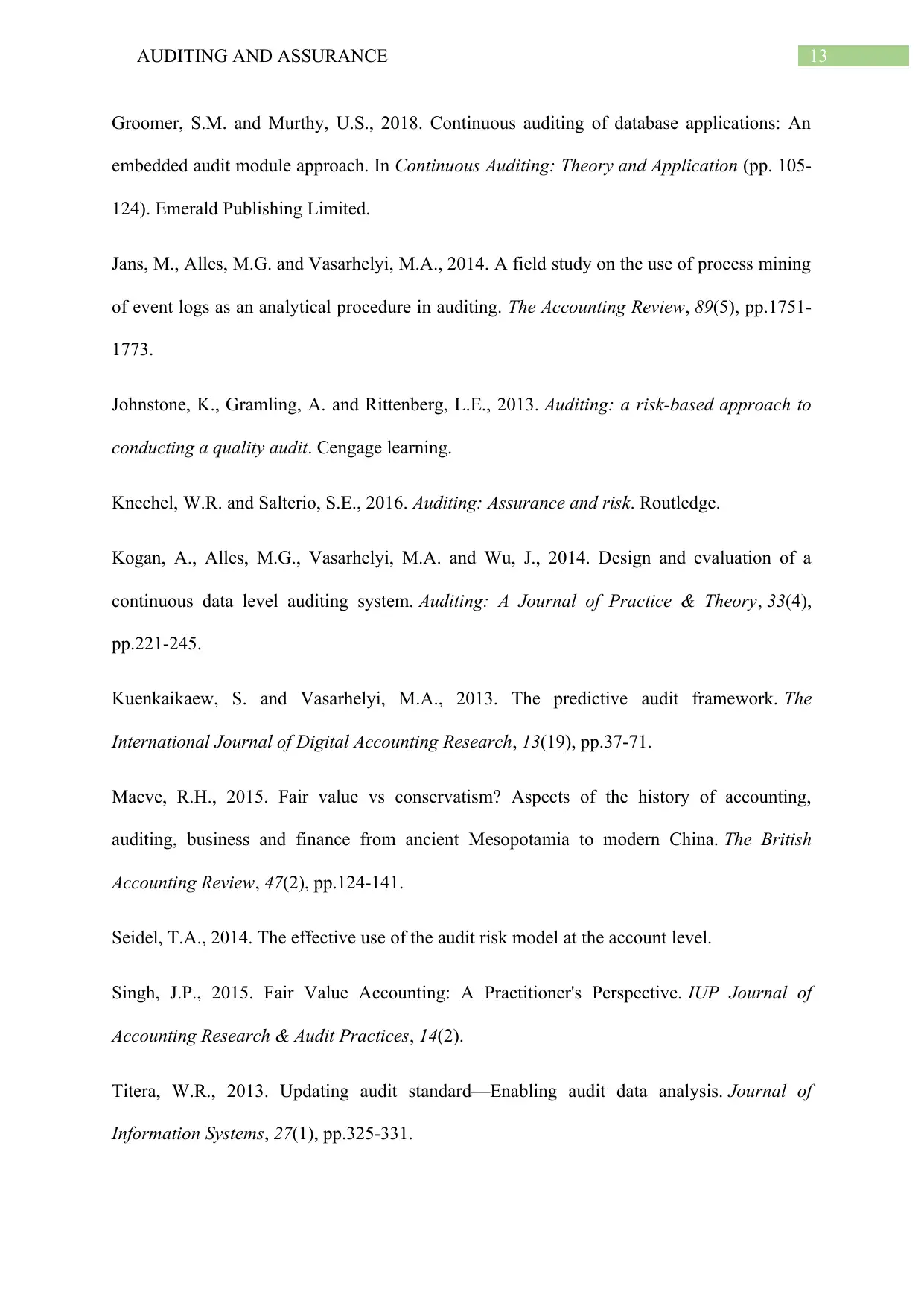
13AUDITING AND ASSURANCE
Groomer, S.M. and Murthy, U.S., 2018. Continuous auditing of database applications: An
embedded audit module approach. In Continuous Auditing: Theory and Application (pp. 105-
124). Emerald Publishing Limited.
Jans, M., Alles, M.G. and Vasarhelyi, M.A., 2014. A field study on the use of process mining
of event logs as an analytical procedure in auditing. The Accounting Review, 89(5), pp.1751-
1773.
Johnstone, K., Gramling, A. and Rittenberg, L.E., 2013. Auditing: a risk-based approach to
conducting a quality audit. Cengage learning.
Knechel, W.R. and Salterio, S.E., 2016. Auditing: Assurance and risk. Routledge.
Kogan, A., Alles, M.G., Vasarhelyi, M.A. and Wu, J., 2014. Design and evaluation of a
continuous data level auditing system. Auditing: A Journal of Practice & Theory, 33(4),
pp.221-245.
Kuenkaikaew, S. and Vasarhelyi, M.A., 2013. The predictive audit framework. The
International Journal of Digital Accounting Research, 13(19), pp.37-71.
Macve, R.H., 2015. Fair value vs conservatism? Aspects of the history of accounting,
auditing, business and finance from ancient Mesopotamia to modern China. The British
Accounting Review, 47(2), pp.124-141.
Seidel, T.A., 2014. The effective use of the audit risk model at the account level.
Singh, J.P., 2015. Fair Value Accounting: A Practitioner's Perspective. IUP Journal of
Accounting Research & Audit Practices, 14(2).
Titera, W.R., 2013. Updating audit standard—Enabling audit data analysis. Journal of
Information Systems, 27(1), pp.325-331.
Groomer, S.M. and Murthy, U.S., 2018. Continuous auditing of database applications: An
embedded audit module approach. In Continuous Auditing: Theory and Application (pp. 105-
124). Emerald Publishing Limited.
Jans, M., Alles, M.G. and Vasarhelyi, M.A., 2014. A field study on the use of process mining
of event logs as an analytical procedure in auditing. The Accounting Review, 89(5), pp.1751-
1773.
Johnstone, K., Gramling, A. and Rittenberg, L.E., 2013. Auditing: a risk-based approach to
conducting a quality audit. Cengage learning.
Knechel, W.R. and Salterio, S.E., 2016. Auditing: Assurance and risk. Routledge.
Kogan, A., Alles, M.G., Vasarhelyi, M.A. and Wu, J., 2014. Design and evaluation of a
continuous data level auditing system. Auditing: A Journal of Practice & Theory, 33(4),
pp.221-245.
Kuenkaikaew, S. and Vasarhelyi, M.A., 2013. The predictive audit framework. The
International Journal of Digital Accounting Research, 13(19), pp.37-71.
Macve, R.H., 2015. Fair value vs conservatism? Aspects of the history of accounting,
auditing, business and finance from ancient Mesopotamia to modern China. The British
Accounting Review, 47(2), pp.124-141.
Seidel, T.A., 2014. The effective use of the audit risk model at the account level.
Singh, J.P., 2015. Fair Value Accounting: A Practitioner's Perspective. IUP Journal of
Accounting Research & Audit Practices, 14(2).
Titera, W.R., 2013. Updating audit standard—Enabling audit data analysis. Journal of
Information Systems, 27(1), pp.325-331.
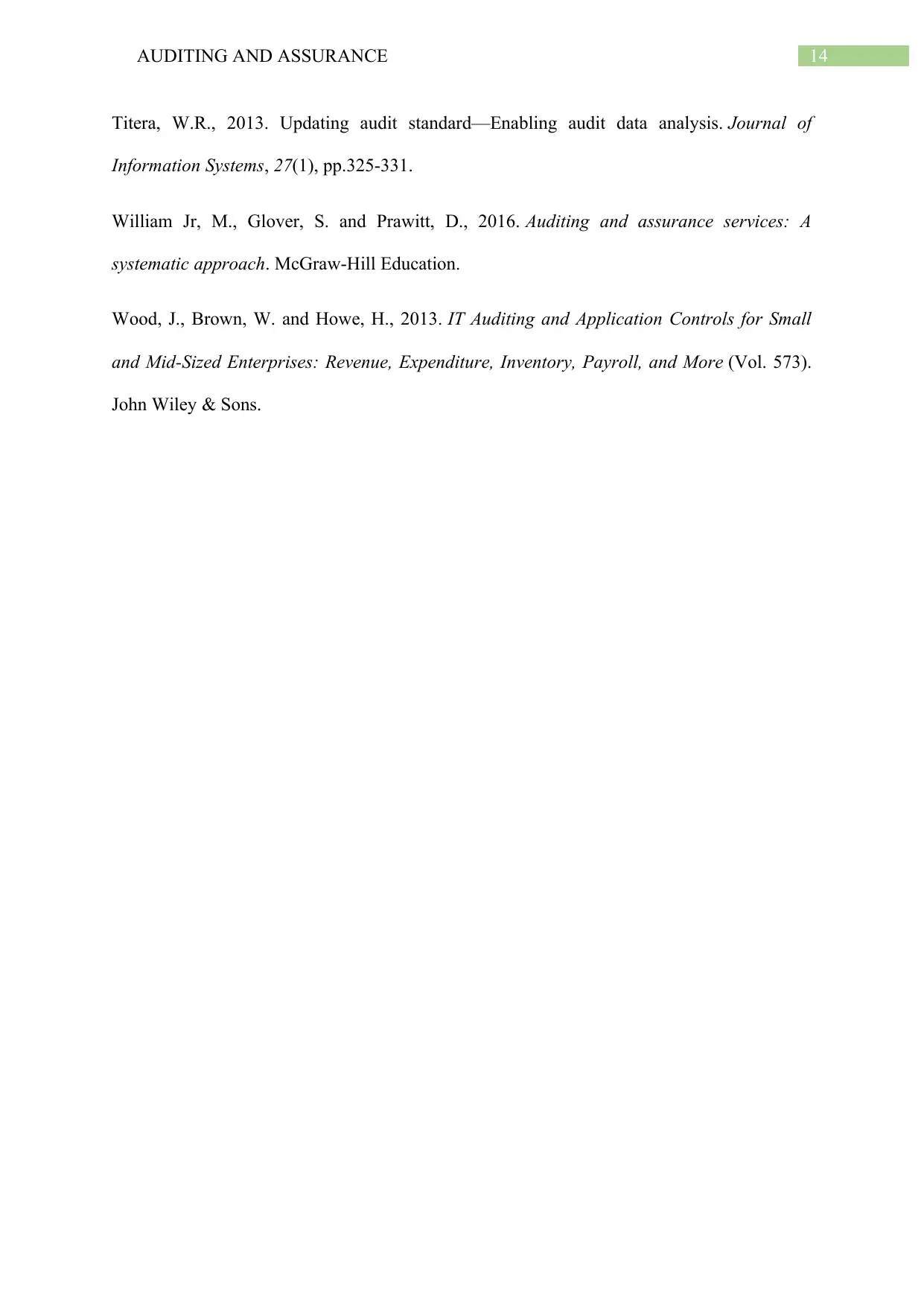
14AUDITING AND ASSURANCE
Titera, W.R., 2013. Updating audit standard—Enabling audit data analysis. Journal of
Information Systems, 27(1), pp.325-331.
William Jr, M., Glover, S. and Prawitt, D., 2016. Auditing and assurance services: A
systematic approach. McGraw-Hill Education.
Wood, J., Brown, W. and Howe, H., 2013. IT Auditing and Application Controls for Small
and Mid-Sized Enterprises: Revenue, Expenditure, Inventory, Payroll, and More (Vol. 573).
John Wiley & Sons.
Titera, W.R., 2013. Updating audit standard—Enabling audit data analysis. Journal of
Information Systems, 27(1), pp.325-331.
William Jr, M., Glover, S. and Prawitt, D., 2016. Auditing and assurance services: A
systematic approach. McGraw-Hill Education.
Wood, J., Brown, W. and Howe, H., 2013. IT Auditing and Application Controls for Small
and Mid-Sized Enterprises: Revenue, Expenditure, Inventory, Payroll, and More (Vol. 573).
John Wiley & Sons.
You're viewing a preview
Unlock full access by subscribing today!
1 out of 15
Related Documents
Your All-in-One AI-Powered Toolkit for Academic Success.
+13062052269
info@desklib.com
Available 24*7 on WhatsApp / Email
![[object Object]](/_next/static/media/star-bottom.7253800d.svg)
Unlock your academic potential
© 2024 | Zucol Services PVT LTD | All rights reserved.




